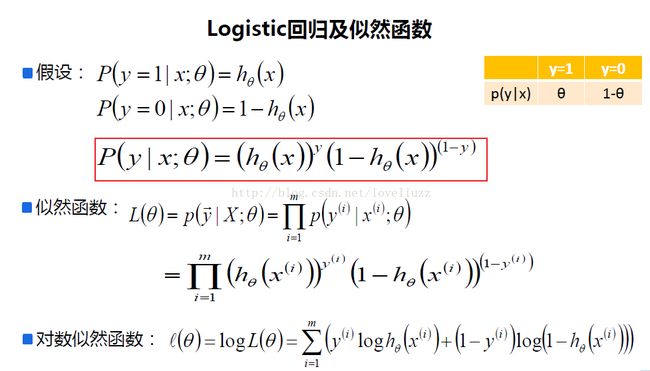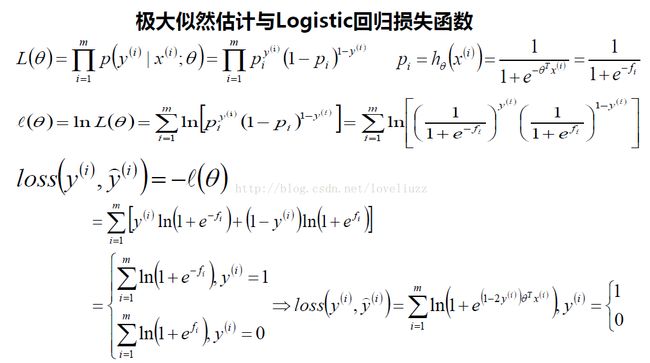机器学习sklearn19.0——Logistic回归算法
一、Logistic回归的认知与应用场景
Logistic回归为概率型非线性回归模型,是研究二分类观察结果![]() 与一些影响因素
与一些影响因素![]() 之间关系的
之间关系的
一种多变量分析方法。通常的问题是,研究某些因素条件下某个结果是否发生,比如医学中根据病人的一些症状
来判断它是否患有某种病。
二、LR分类器
LR分类器,即Logistic Regression Classifier。
在分类情形下,经过学习后的LR分类器是一组权值![]() ,当测试样本的数据输入时,这组权值与测试数据按
,当测试样本的数据输入时,这组权值与测试数据按
照线性加和得到 ![]() ,这里
,这里![]() 是每个样本的
是每个样本的![]() 个特征。
个特征。
按照sigmoid函数的形式求出  ,其中sigmoid函数的定义域为
,其中sigmoid函数的定义域为![]() ,值域为
,值域为![]() ,因此最基本的LR分类器适合对两类目标进行分类。
,因此最基本的LR分类器适合对两类目标进行分类。
所以Logistic回归最关键的问题就是研究如何求得![]() 这组权值。这个问题是用极大似然估计来做的。
这组权值。这个问题是用极大似然估计来做的。
三、Logistic回归模型
考虑具有![]() 个独立变量的向量
个独立变量的向量![]() ,设条件慨率
,设条件慨率![]() 为
为
根据观测量相对于某事件![]() 发生的概率。那么Logistic回归模型可以表示为
发生的概率。那么Logistic回归模型可以表示为 
这个比值称为事件的发生比(the odds of experiencing an event),简记为odds。
小结:
一般来说,回归不用在分类问题上,因为回归是连续型模型,而且受噪声影响比较大。
如果非要应用在分类问题上,可以使用logistic回归。
logistic回归本质上是线性回归,只是在特征到结果的映射中加入了一层函数映射,
即先把特征线性求和,然后使用函数g(z)将做为假设函数来预测。g(z)可以将连续值映射到0和1上。
logistic回归的假设函数如下所示,线性回归假设函数只是![]() 。
。
logistic回归用来分类0/1问题,也就是预测结果属于0或者1的二值分类问题。
这里假设了二值满足伯努利分布(0/1分布或两点分布),也就是
四、logistic回归应用案例
(1)sklearn中对LogisticRegressionCV函数的解析
(2)代码如下:
文件链接如下:链接:https://pan.baidu.com/s/1dEWUEhb 密码:bm1p
-
#!/usr/bin/env python -
# -*- coding:utf-8 -*- -
# Author:ZhengzhengLiu -
#乳腺癌分类案例 -
import sklearn -
from sklearn.linear_model import LogisticRegressionCV,LinearRegression -
from sklearn.model_selection import train_test_split -
from sklearn.preprocessing import StandardScaler -
from sklearn.linear_model.coordinate_descent import ConvergenceWarning -
import numpy as np -
import pandas as pd -
import matplotlib as mpl -
import matplotlib.pyplot as plt -
import warnings -
#解决中文显示问题 -
mpl.rcParams["font.sans-serif"] = [u"SimHei"] -
mpl.rcParams["axes.unicode_minus"] = False -
#拦截异常 -
warnings.filterwarnings(action='ignore',category=ConvergenceWarning) -
#导入数据并对异常数据进行清除 -
path = "datas/breast-cancer-wisconsin.data" -
names = ["id","Clump Thickness","Uniformity of Cell Size","Uniformity of Cell Shape" -
,"Marginal Adhesion","Single Epithelial Cell Size","Bare Nuclei","Bland Chromatin" -
,"Normal Nucleoli","Mitoses","Class"] -
df = pd.read_csv(path,header=None,names=names) -
datas = df.replace("?",np.nan).dropna(how="any") #只要列中有nan值,进行行删除操作 -
#print(datas.head()) #默认显示前五行 -
#数据提取与数据分割 -
X = datas[names[1:10]] -
Y = datas[names[10]] -
#划分训练集与测试集 -
X_train,X_test,Y_train,Y_test = train_test_split(X,Y,test_size=0.1,random_state=0) -
#对数据的训练集进行标准化 -
ss = StandardScaler() -
X_train = ss.fit_transform(X_train) #先拟合数据在进行标准化 -
#构建并训练模型 -
## multi_class:分类方式选择参数,有"ovr(默认)"和"multinomial"两个值可选择,在二元逻辑回归中无区别 -
## cv:几折交叉验证 -
## solver:优化算法选择参数,当penalty为"l1"时,参数只能是"liblinear(坐标轴下降法)" -
## "lbfgs"和"cg"都是关于目标函数的二阶泰勒展开 -
## 当penalty为"l2"时,参数可以是"lbfgs(拟牛顿法)","newton_cg(牛顿法变种)","seg(minibactch随机平均梯度下降)" -
## 维度<10000时,选择"lbfgs"法,维度>10000时,选择"cs"法比较好,显卡计算的时候,lbfgs"和"cs"都比"seg"快 -
## penalty:正则化选择参数,用于解决过拟合,可选"l1","l2" -
## tol:当目标函数下降到该值是就停止,叫:容忍度,防止计算的过多 -
lr = LogisticRegressionCV(multi_class="ovr",fit_intercept=True,Cs=np.logspace(-2,2,20),cv=2,penalty="l2",solver="lbfgs",tol=0.01) -
re = lr.fit(X_train,Y_train) -
#模型效果获取 -
r = re.score(X_train,Y_train) -
print("R值(准确率):",r) -
print("参数:",re.coef_) -
print("截距:",re.intercept_) -
print("稀疏化特征比率:%.2f%%" %(np.mean(lr.coef_.ravel()==0)*100)) -
print("=========sigmoid函数转化的值,即:概率p=========") -
print(re.predict_proba(X_test)) #sigmoid函数转化的值,即:概率p -
#模型的保存与持久化 -
from sklearn.externals import joblib -
joblib.dump(ss,"logistic_ss.model") #将标准化模型保存 -
joblib.dump(lr,"logistic_lr.model") #将训练后的线性模型保存 -
joblib.load("logistic_ss.model") #加载模型,会保存该model文件 -
joblib.load("logistic_lr.model") -
#预测 -
X_test = ss.transform(X_test) #数据标准化 -
Y_predict = lr.predict(X_test) #预测 -
#画图对预测值和实际值进行比较 -
x = range(len(X_test)) -
plt.figure(figsize=(14,7),facecolor="w") -
plt.ylim(0,6) -
plt.plot(x,Y_test,"ro",markersize=8,zorder=3,label=u"真实值") -
plt.plot(x,Y_predict,"go",markersize=14,zorder=2,label=u"预测值,$R^2$=%.3f" %lr.score(X_test,Y_test)) -
plt.legend(loc="upper left") -
plt.xlabel(u"数据编号",fontsize=18) -
plt.ylabel(u"乳癌类型",fontsize=18) -
plt.title(u"Logistic算法对数据进行分类",fontsize=20) -
plt.savefig("Logistic算法对数据进行分类.png") -
plt.show() -
print("=============Y_test==============") -
print(Y_test.ravel()) -
print("============Y_predict============") -
print(Y_predict) -
#运行结果: -
R值(准确率): 0.970684039088 -
参数: [[ 1.3926311 0.17397478 0.65749877 0.8929026 0.36507062 1.36092964 -
0.91444624 0.63198866 0.75459326]] -
截距: [-1.02717163] -
稀疏化特征比率:0.00% -
=========sigmoid函数转化的值,即:概率p========= -
[[ 6.61838068e-06 9.99993382e-01] -
[ 3.78575185e-05 9.99962142e-01] -
[ 2.44249065e-15 1.00000000e+00] -
[ 0.00000000e+00 1.00000000e+00] -
[ 1.52850624e-03 9.98471494e-01] -
[ 6.67061684e-05 9.99933294e-01] -
[ 6.75536843e-07 9.99999324e-01] -
[ 0.00000000e+00 1.00000000e+00] -
[ 2.43117004e-05 9.99975688e-01] -
[ 6.13092842e-04 9.99386907e-01] -
[ 0.00000000e+00 1.00000000e+00] -
[ 2.00330728e-06 9.99997997e-01] -
[ 0.00000000e+00 1.00000000e+00] -
[ 3.78575185e-05 9.99962142e-01] -
[ 4.65824155e-08 9.99999953e-01] -
[ 5.47788703e-10 9.99999999e-01] -
[ 0.00000000e+00 1.00000000e+00] -
[ 0.00000000e+00 1.00000000e+00] -
[ 0.00000000e+00 1.00000000e+00] -
[ 6.27260778e-07 9.99999373e-01] -
[ 3.78575185e-05 9.99962142e-01] -
[ 3.85098865e-06 9.99996149e-01] -
[ 1.80189197e-12 1.00000000e+00] -
[ 9.44640398e-05 9.99905536e-01] -
[ 0.00000000e+00 1.00000000e+00] -
[ 0.00000000e+00 1.00000000e+00] -
[ 4.11688915e-06 9.99995883e-01] -
[ 1.85886872e-05 9.99981411e-01] -
[ 5.83016713e-06 9.99994170e-01] -
[ 0.00000000e+00 1.00000000e+00] -
[ 1.52850624e-03 9.98471494e-01] -
[ 0.00000000e+00 1.00000000e+00] -
[ 0.00000000e+00 1.00000000e+00] -
[ 1.51713085e-05 9.99984829e-01] -
[ 2.34685008e-05 9.99976531e-01] -
[ 1.51713085e-05 9.99984829e-01] -
[ 0.00000000e+00 1.00000000e+00] -
[ 0.00000000e+00 1.00000000e+00] -
[ 2.34685008e-05 9.99976531e-01] -
[ 0.00000000e+00 1.00000000e+00] -
[ 9.97563915e-07 9.99999002e-01] -
[ 1.70686321e-07 9.99999829e-01] -
[ 1.38382134e-04 9.99861618e-01] -
[ 1.36080718e-04 9.99863919e-01] -
[ 1.52850624e-03 9.98471494e-01] -
[ 1.68154251e-05 9.99983185e-01] -
[ 6.66097483e-04 9.99333903e-01] -
[ 0.00000000e+00 1.00000000e+00] -
[ 9.77502258e-07 9.99999022e-01] -
[ 5.83016713e-06 9.99994170e-01] -
[ 0.00000000e+00 1.00000000e+00] -
[ 4.09496721e-06 9.99995905e-01] -
[ 0.00000000e+00 1.00000000e+00] -
[ 1.37819117e-06 9.99998622e-01] -
[ 6.27260778e-07 9.99999373e-01] -
[ 4.52734741e-07 9.99999547e-01] -
[ 0.00000000e+00 1.00000000e+00] -
[ 8.88178420e-16 1.00000000e+00] -
[ 1.06976766e-08 9.99999989e-01] -
[ 0.00000000e+00 1.00000000e+00] -
[ 2.45780192e-04 9.99754220e-01] -
[ 3.92389040e-04 9.99607611e-01] -
[ 6.10681985e-05 9.99938932e-01] -
[ 9.44640398e-05 9.99905536e-01] -
[ 1.51713085e-05 9.99984829e-01] -
[ 2.45780192e-04 9.99754220e-01] -
[ 2.45780192e-04 9.99754220e-01] -
[ 1.51713085e-05 9.99984829e-01] -
[ 0.00000000e+00 1.00000000e+00]] -
=============Y_test============== -
[2 2 4 4 2 2 2 4 2 2 4 2 4 2 2 2 4 4 4 2 2 2 4 2 4 4 2 2 2 4 2 4 4 2 2 2 4 -
4 2 4 2 2 2 2 2 2 2 4 2 2 4 2 4 2 2 2 4 2 2 4 2 2 2 2 2 2 2 2 4] -
============Y_predict============ -
[2 2 4 4 2 2 2 4 2 2 4 2 4 2 2 2 4 4 4 2 2 2 4 2 4 4 2 2 2 4 2 4 4 2 2 2 4 -
4 2 4 2 2 2 2 2 2 2 4 2 2 4 2 4 2 2 2 4 4 2 4 2 2 2 2 2 2 2 2 4]
五、softmax回归——多分类问题
(1)softmax回归定义与概述
(2)softmax回归案例分析——葡萄酒质量预测模型
-
#!/usr/bin/env python -
# -*- coding:utf-8 -*- -
# Author:ZhengzhengLiu -
#葡萄酒质量预测模型 -
import numpy as np -
import matplotlib as mpl -
import matplotlib.pyplot as plt -
import pandas as pd -
import warnings -
import sklearn -
from sklearn.linear_model import LogisticRegressionCV -
from sklearn.linear_model.coordinate_descent import ConvergenceWarning -
from sklearn.model_selection import train_test_split -
from sklearn.preprocessing import StandardScaler -
from sklearn.preprocessing import MinMaxScaler -
from sklearn.preprocessing import label_binarize -
from sklearn import metrics -
#解决中文显示问题 -
mpl.rcParams['font.sans-serif']=[u'simHei'] -
mpl.rcParams['axes.unicode_minus']=False -
#拦截异常 -
warnings.filterwarnings(action = 'ignore', category=ConvergenceWarning) -
#导入数据 -
path1 = "datas/winequality-red.csv" -
df1 = pd.read_csv(path1, sep=";") -
df1['type'] = 1 -
path2 = "datas/winequality-white.csv" -
df2 = pd.read_csv(path2, sep=";") -
df2['type'] = 2 -
df = pd.concat([df1,df2], axis=0) -
names = ["fixed acidity","volatile acidity","citric acid", -
"residual sugar","chlorides","free sulfur dioxide", -
"total sulfur dioxide","density","pH","sulphates", -
"alcohol", "type"] -
quality = "quality" -
#print(df.head(5)) -
#对异常数据进行清除 -
new_df = df.replace('?', np.nan) -
datas = new_df.dropna(how = 'any') -
print ("原始数据条数:%d;异常数据处理后数据条数:%d;异常数据条数:%d" % (len(df), len(datas), len(df) - len(datas))) -
#数据提取与数据分割 -
X = datas[names] -
Y = datas[quality] -
#划分训练集与测试集 -
X_train,X_test,Y_train,Y_test = train_test_split(X,Y,test_size=0.25,random_state=0) -
print ("训练数据条数:%d;数据特征个数:%d;测试数据条数:%d" % (X_train.shape[0], X_train.shape[1], X_test.shape[0])) -
#对数据的训练集进行标准化 -
mms = MinMaxScaler() -
X_train = mms.fit_transform(X_train) -
#构建并训练模型 -
lr = LogisticRegressionCV(fit_intercept=True, Cs=np.logspace(-5, 1, 100), -
multi_class='multinomial', penalty='l2', solver='lbfgs') -
lr.fit(X_train, Y_train) -
##模型效果获取 -
r = lr.score(X_train, Y_train) -
print ("R值:", r) -
print ("特征稀疏化比率:%.2f%%" % (np.mean(lr.coef_.ravel() == 0) * 100)) -
print ("参数:",lr.coef_) -
print ("截距:",lr.intercept_) -
#预测 -
X_test = mms.transform(X_test) -
Y_predict = lr.predict(X_test) -
#画图对预测值和实际值进行比较 -
x_len = range(len(X_test)) -
plt.figure(figsize=(14,7), facecolor='w') -
plt.ylim(-1,11) -
plt.plot(x_len, Y_test, 'ro',markersize = 8, zorder=3, label=u'真实值') -
plt.plot(x_len, Y_predict, 'go', markersize = 12, zorder=2, label=u'预测值,$R^2$=%.3f' % lr.score(X_train, Y_train)) -
plt.legend(loc = 'upper left') -
plt.xlabel(u'数据编号', fontsize=18) -
plt.ylabel(u'葡萄酒质量', fontsize=18) -
plt.title(u'葡萄酒质量预测统计', fontsize=20) -
plt.savefig("葡萄酒质量预测统计.png") -
plt.show() -
#运行结果: -
原始数据条数:6497;异常数据处理后数据条数:6497;异常数据条数:0 -
训练数据条数:4872;数据特征个数:12;测试数据条数:1625 -
R值: 0.549466338259 -
特征稀疏化比率:0.00% -
参数: [[ 0.97934119 2.16608604 -0.41710039 -0.49330657 0.90621136 1.44813439 -
0.75463562 0.2311527 0.01015772 -0.69598672 -0.71473577 -0.2907567 ] -
[ 0.62487587 5.11612885 -0.38168837 -2.16145905 1.21149753 -3.71928146 -
-1.45623362 1.34125165 0.33725355 -0.86655787 -2.7469681 2.02850838] -
[-1.73828753 1.96024965 0.48775556 -1.91223567 0.64365084 -1.67821019 -
2.20322661 1.49086179 -1.36192671 -2.2337436 -5.01452059 -0.75501299] -
[-1.19975858 -2.60860814 -0.34557812 0.17579494 -0.04388969 0.81453743 -
-0.28250319 0.51716692 -0.67756552 0.18480087 0.01838834 -0.71392084] -
[ 1.15641271 -4.6636028 -0.30902483 2.21225522 -2.00298042 1.66691445 -
-1.02831849 -2.15017982 0.80529532 2.68270545 3.36326129 -0.73635195] -
[-0.07892353 -1.82724304 0.69405191 2.07681409 -0.6247279 1.49244742 -
-0.16115782 -1.3671237 0.72694885 1.06878382 4.68718155 0.04669067] -
[ 0.25633987 -0.14301056 0.27158425 0.10213705 -0.08976172 -0.02454203 -
-0.02964911 -0.06312954 0.15983679 -0.14000195 0.40739327 0.42084343]] -
截距: [-2.34176729 -1.1649153 4.91027564 4.3206539 1.30164164 -2.25841567 -
-4.76747291]
六、分类问题综合案例——鸢尾花分类问题、ROC/AUC
(1)知识点——python自带内置函数zip()函数
(2)知识点——sklearn.model_selection.train_test_split——随机划分训练集与测试集
(3)知识点——ROC曲线
详细链接地址:http://blog.csdn.net/abcjennifer/article/details/7359370
(4)知识点——所涉及到的几种 sklearn 的二值化编码函数:
OneHotEncoder(), LabelEncoder(), LabelBinarizer(), MultiLabelBinarizer()
详细链接地址为:http://blog.csdn.net/gao1440156051/article/details/55096630
案例代码:
-
#!/usr/bin/env python -
# -*- coding:utf-8 -*- -
# Author:ZhengzhengLiu -
#分类综合问题——鸢尾花分类案例(ROC/AUC) -
import numpy as np -
import matplotlib as mpl -
import matplotlib.pyplot as plt -
import pandas as pd -
import warnings -
import sklearn -
from sklearn.linear_model import LogisticRegressionCV -
from sklearn.linear_model.coordinate_descent import ConvergenceWarning -
from sklearn.model_selection import train_test_split -
from sklearn.preprocessing import StandardScaler -
from sklearn.neighbors import KNeighborsClassifier -
from sklearn.preprocessing import label_binarize -
from sklearn import metrics -
#解决中文显示问题 -
mpl.rcParams['font.sans-serif']=[u'simHei'] -
mpl.rcParams['axes.unicode_minus']=False -
#拦截异常 -
warnings.filterwarnings(action = 'ignore', category=ConvergenceWarning) -
#导入数据 -
path = "datas/iris.data" -
names = ['sepal length', 'sepal width', 'petal length', 'petal width', 'cla'] -
df = pd.read_csv(path,header=None,names=names) -
print(df['cla'].value_counts()) -
print(df.head()) -
#编码函数 -
def parseRecord(record): #record是数据集 -
result = [] -
# zip() 函数接受一系列可迭代的对象作为参数,将对象中对应的元素按顺序组合成一个tuple, -
# 每个tuple中包含的是原有序列中对应序号位置的元素,然后返回由这些tuples组成的list。 -
r = zip(names,record) -
for name,v in r: -
if name == "cla": -
if v == "Iris-setosa": -
result.append(1) -
elif v == "Iris-versicolor": -
result.append(2) -
elif v == "Iris-virginica": -
result.append(3) -
else: -
result.append(np.nan) -
else: -
result.append(float(v)) -
return result -
#数据转换为数字以及分割 -
#数据转换 -
datas = df.apply(lambda r:parseRecord(r),axis=1) -
print(datas.head()) -
#异常数据删除 -
datas = datas.dropna(how="any") -
#数据分割 -
X = datas[names[0:-1]] -
Y = datas[names[-1]] -
#划分训练集与测试集 -
X_train,X_test,Y_train,Y_test = train_test_split(X,Y,test_size=0.4,random_state=0) -
print("原始数据条数:%d;训练数据条数:%d;特征个数:%d;测试样本条数:%d" %(len(X),len(X_train),X_train.shape[1],len(X_test))) -
#对数据集进行标准化 -
ss = StandardScaler() -
X_train = ss.fit_transform(X_train) -
X_test = ss.transform(X_test) -
#构建并训练模型 -
lr = LogisticRegressionCV(Cs=np.logspace(-4,1,50),cv=3,fit_intercept=True,penalty="l2", -
solver="lbfgs",tol=0.01,multi_class="multinomial") -
lr.fit(X_train,Y_train) -
#模型效果获取 -
#将测试集标签数据用二值化编码的方式转换为矩阵 -
y_test_hot = label_binarize(Y_test,classes=(1,2,3)) -
#得到预测的损失值 -
lr_y_score = lr.decision_function(X_test) -
#计算ROC的值,lr_threasholds为阈值 -
lr_fpr,lr_tpr,lr_threasholds = metrics.roc_curve(y_test_hot.ravel(),lr_y_score.ravel()) -
#计算AUC值 -
lr_auc = metrics.auc(lr_fpr,lr_tpr) -
print("Logistic算法R值:",lr.score(X_train,Y_train)) -
print("Logistic算法AUC值:",lr_auc) -
#模型预测 -
lr_y_predict = lr.predict(X_test) -
#画图对预测值和实际值进行比较 -
plt.figure(figsize=(8,6),facecolor="w") -
plt.plot(lr_fpr,lr_tpr,c="r",lw=2,label=u"Logistic算法,AUC=%.3f" %lr_auc) -
plt.plot((0,1),(0,1),c='#a0a0a0',lw=2,ls='--') -
plt.xlim(-0.01,1.02) -
plt.ylim(-0.01,1.02) -
plt.xticks(np.arange(0, 1.1, 0.1)) -
plt.yticks(np.arange(0, 1.1, 0.1)) -
plt.xlabel('False Positive Rate(FPR)', fontsize=16) -
plt.ylabel('True Positive Rate(TPR)', fontsize=16) -
plt.grid(b=True, ls=':') -
plt.legend(loc='lower right', fancybox=True, framealpha=0.8, fontsize=12) -
plt.title(u'鸢尾花数据Logistic算法的ROC/AUC', fontsize=18) -
plt.savefig("鸢尾花数据Logistic算法的ROC和AUC.png") -
plt.show() -
len_x_test = range(len(X_test)) -
plt.figure(figsize=(12,9),facecolor="w") -
plt.ylim(0.5,3.5) -
plt.plot(len_x_test,Y_test,"ro",markersize=6,zorder=3,label=u"真实值") -
plt.plot(len_x_test,lr_y_predict,"go",markersize=10,zorder=2,label=u"Logis算法预测值,$R^2=%.3f$" %lr.score(X_test,Y_test)) -
plt.legend(loc = 'lower right') -
plt.xlabel(u'数据编号', fontsize=18) -
plt.ylabel(u'种类', fontsize=18) -
plt.title(u'鸢尾花数据分类', fontsize=20) -
plt.savefig("鸢尾花数据分类.png") -
plt.show() -
#运行结果: -
Iris-versicolor 50 -
Iris-setosa 50 -
Iris-virginica 50 -
Name: cla, dtype: int64 -
sepal length sepal width petal length petal width cla -
0 5.1 3.5 1.4 0.2 Iris-setosa -
1 4.9 3.0 1.4 0.2 Iris-setosa -
2 4.7 3.2 1.3 0.2 Iris-setosa -
3 4.6 3.1 1.5 0.2 Iris-setosa -
4 5.0 3.6 1.4 0.2 Iris-setosa -
sepal length sepal width petal length petal width cla -
0 5.1 3.5 1.4 0.2 1.0 -
1 4.9 3.0 1.4 0.2 1.0 -
2 4.7 3.2 1.3 0.2 1.0 -
3 4.6 3.1 1.5 0.2 1.0 -
4 5.0 3.6 1.4 0.2 1.0 -
原始数据条数:150;训练数据条数:90;特征个数:4;测试样本条数:60 -
Logistic算法R值: 0.977777777778 -
Logistic算法AUC值: 0.926944444444






























